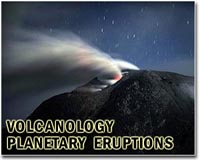| . |  |
. |
Reykjavik (AFP) April 19, 2010 Iceland's Eyjafjoell volcano has started spewing out less ash, a sign the eruption could be tapering off and that Europe's air traffic nightmare could be coming to an end, experts said Monday. "Currently the eruption has diminished markedly," Bryndis Brandsdottir of the University of Iceland told AFP, basing her comment on seismological radar readings in Reykjavik. "The ash column does not rise above 3,000 metres (9,800 feet)," or less than half its original height, she said, pointing out that "the amount of tethra (a type of ash that makes up the volcano plume) has diminished to the point that (experts monitoring the eruption) could not see the column." Icelandic geophysicist and civil protection advisor Magnus Tumi Gudmundsson agreed that the ash column from the Eyjafjoell eruption -- which has paralysed air travel in most of Europe -- was decreasing, six days after it began. "Less ash has been generated over the last 36 hours than previously. The ash production has been reduced," he told AFP. This could be good news for the millions of stranded travelers around the world waiting for more airspace to open up, since at just 3,000 metres, the ash "is hardly transported far away," Brandsdottir said. Haakon Melhuus, a meteorologist at the Norwegian Meteorological Institute in Olso, agreed. "The fact that (the column) is lower means it will move more with ground air and not follow the high air currents as much," he said, adding that there thereby would be a lower concentration of ash in the air that would be spread to a much smaller area. "Winds at higher altitudes are much stronger than down by the ground and go much further," he told AFP. When it initially erupted early Wednesday, the Eyjafjoell volcano spewed a column of volcanic plume up to 9,000 metres (29,527 feet) into the air. That column produced a cloud of ash that was transported to Europe by high level winds, causing the shutdown of airspace across a wide swath of the continent, because ash can damage aircraft engines. The column of plume has oscillated between 6,000 and 8,000 metres since the initial burst, so the reduction to just 3,000 metres on Monday could indicated a major change in volcanic activity, experts said. "The fact that the smoke is not going as high as it has earlier, indicates that the (volcano's) activity has diminished and the (air) temperature is lower," Melhuss said, pointing out that the hotter volcanic air gets, the higher the plume of ash shoots into the sky. "If (the air) cools a bit, it will not go as high into the atmosphere and it will not be transported as far from the origin as before," he said. According to Brandsdottirm the eruption started decreasing Sunday afternoon, but it had been difficult to monitor the volcano at the time "because of weather and clouds." Seismological radars in Reykjavik had also picked up additional tremors near the Eyjafjoell volcano that began erupting for the second time in less than a month last Wednesday, she said. But she stressed seismometers not only measured volcanic tremors but also recorded exterior seismic factors such as strong winds and tremors produced by the ocean. "The North Atlantic ocean can also produce tremors. The increase in tremors overnight yesterday is partly associated with the strong northerly winds," blowing ash to the south, she said. Other experts have in recent days said there were signs the ongoing eruption was tapering off, but also warned possibly more powerful eruptions could be in the works.
Share This Article With Planet Earth
Related Links Bringing Order To A World Of Disasters When the Earth Quakes A world of storm and tempest
 Vanuatu prepares to evacuate 3,000 from rumbling volcano
Vanuatu prepares to evacuate 3,000 from rumbling volcanoSydney (AFP) April 19, 2010 The Pacific nation of Vanuatu has made plans to evacuate nearly 3,000 villagers after a highly active volcano started spewing ash clouds, an official said on Monday. The picturesque Gaua volcano, which has erupted 13 times since 1963 and has been exploding and rumbling for several months, is under close watch after a marked rise in activity in recent days. "It's increasing in activity," ... read more |
|
| The content herein, unless otherwise known to be public domain, are Copyright 1995-2010 - SpaceDaily. AFP and UPI Wire Stories are copyright Agence France-Presse and United Press International. ESA Portal Reports are copyright European Space Agency. All NASA sourced material is public domain. Additional copyrights may apply in whole or part to other bona fide parties. Advertising does not imply endorsement,agreement or approval of any opinions, statements or information provided by SpaceDaily on any Web page published or hosted by SpaceDaily. Privacy Statement |